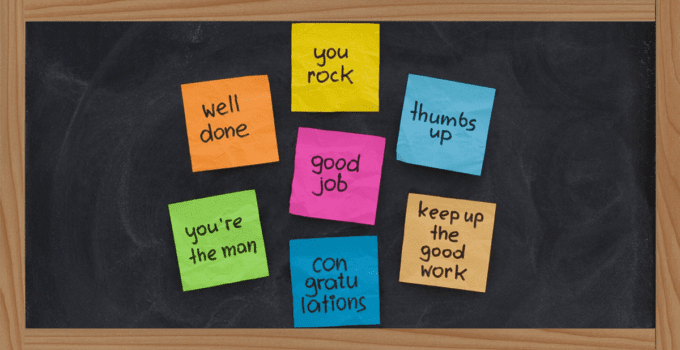There’s never a bad time for performance evaluations. However, performance evaluations can be frustrating and worrisome for both the recipients of the performance reviews, as well as those administering them. Here are 5 tricks for improving your performance evaluation process. Evaluate yourself first. Some companies include a self-assessment portion of the evaluation process. Whether your company includes that step or not, it’s worthwhile to take the time to evaluate yourself for several reasons—to know how you’ve progressed from your own perspective, to have a comparison of how your own perspective compares to your manager’s perspective of your progress, and to
The logic behind employee appreciation is a simple concept—make employees feel appreciated, and they’ll work harder and be more loyal. But complexity comes into the situation when there is a disconnect between the type of appreciation managers come up with, and the type of appreciation employees respond to. In a recent California study, managers responded that cash-based bonuses and promotions were the most effective methods, while employees preferred a “job-well-done” comment in person, or having their well-done efforts reported to upper management. You’re probably thinking, “Well that’s much easier than raising their pay,” but you’d be surprised. For a significant
Wanting recognition for completing work above and beyond the minimum requirement is a natural human need. Financial rewards and praise for average work can only go so far. In order to continue to receive above average work, you must be willing to give above average recognition. There are 5 aspects to think about to provide satisfactory employee recognition to your above average employees: In the moment – Timeliness is key; acknowledging good efforts is most effective when it is done as soon as it is recognized. In context – Relating your employee recognition to a specific business goal is more
Like a well-tuned vehicle, an effective employee retention strategy requires regular checkups and maintenance. If your retention strategy seems worn out, don’t be discouraged—a minor tune-up may be all you need. Keep your employee retention strategy running smoothly with these 3 checklist items, courtesy of Business News Daily. Be sure your strategy agrees with these 3 points: Focuses on career paths Although it may seem that money is the main incentive for employees to perform, research has proven that opportunities for growth and development are more influential. When your retention strategy is more customized towards individuals’ career paths, your employees
According to IDC, U.S. and U.K. employees cost businesses approximately $37 billion each year due to a lack of understanding of their roles and requirements. Not only does employee onboarding reduce on-the-job learning costs, it also saves time on training, as well as increases morale and turnover. Remember these rules to work by for the optimal employee onboarding experience. Always have necessary paperwork ready. Any clerical work should be done before the employee’s first day, so they can spend their first day practicing their trade instead of signing forms. Give the employee your undivided attention. Orientation sessions are top priority
According to a study from the staffing firm Robert Half Management Resources, only 10 percent of employees surveyed said their organization has an internal backup to replace them if they leave. As for the executives surveyed, only 8 percent have a replacement ready to fill their role when they leave. Succession planning is a necessary aspect of any organization; however, it is often overlooked. Be part of the 10 percent that is prepared—and help that statistic grow—with these succession planning tips. Focus on the next generation. Ideally, the successor of any role in an organization comes from the next
Workforce development is a function of human resources responsible for helping job seekers acquire skills that employers are looking for. A survey conducted by the Pennsylvania Chamber of Business and Industry found that one third of PA companies were having a “very or extremely difficult” time hiring employees with the right skills. And more than half of the respondents expect this difficulty to get worse over the next five years. So what seems to be the problem when it comes to workforce development? Simply put, it can be explained like this: even when the skill training and education is on
April 4th, 2017 – A Waco-based employee assessment company has cause for celebration today, as their international presence expands to include Australia, New Zealand, and 18 other Australasian countries. Through their partnership with Peoplogica, an Australia-based talent management specialty provider, Talexes looks forward to the opportunity to expand upon their mission to improve the quality of hire across the workforce in all areas of the globe. Peoplogica is a leading people analytics provider in customer centricity and attracting, selecting and retaining high performing talent. They deliver a range of customized people capital solutions to organizations of all sizes, from all
With more individuals joining the workforce every day, 2017 is going to be a busy year for hiring and talent managers. That means new talent acquisition techniques and trends. A rapidly emerging trend is a shift toward employee assessments. With this new pre-employment screening process, organizations are beginning to understand that personality and cognitive testing combined can predict whether a person can learn the job tasks quickly and think critically. With the average tenure of a 25 to 34-year-old employee at a mere 3 years, finding a successful job fit is crucial. However, medium and small-scale businesses are often left
When hiring managers and recruiters use their discretion to overrule the results of employee assessments, their hires do less well than workers selected exclusively on the basis of test scores, according to TLNT.com. This information is based on the data gathered by a trio of researchers—Mitchell Hoffman of the University of Toronto’s School of Management, Lisa Kahn of Yale’s School of Management, and Danielle Li of Harvard Business School—who studied the tenure and performance of 300,000 hires at 15 different companies. It was concluded that managers who exercise more discretion have a flawed talent acquisition process, causing them to systematically









